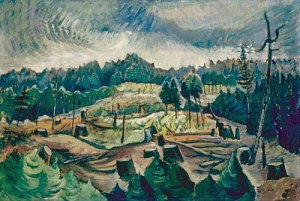
Emily Carr
Logged-Over Hillside (c. 1940)
As we approach the depths of summer, my mind wanders westward across the canadian border and into the province of British Columbia, where the air is cooler and the mountains higher. I’ve always been drawn to the canvases of Emily Carr and recently I undertook a larger project that examined the legacy of her work in contemporary Canadian painting. Logged-over hillside was a painting that figured prominently in that paper.
Throughout her life, the landscape surrounding her hometown of Victoria on Vancouver Island held Emily Carr emotionally and artistically captivated. Her depictions of the British Columbian coast and forests have been called “unique,” “revolutionary,” “the first conscious expression of the rhythm of life,” and above all “preeminently Canadian.”
Carr’s entire life had been rooted in Victoria. It was always her home base and from there she had seen Vancouver Island and lower British Columbia transition from small settler communities to growing cities with industry and commerce. The landscape around her was undergoing dramatic changes as loggers and sawmills exercised their will on British Columbia’s boreal forests.
In the cleared stretches that sliced through the forests near her home, Carr saw the sky intermingle with the newly exposed undergrowth. For her they were spaces where movement and life broiled and the potential for re-growth was uninhibited. The changes to Carr’s Vancouver Island setting brought about by logging offered her new aesthetic possibilities and presented her with the dynamic and ideal space she longed to paint. This is not to say that Carr was blind or desensitized to the destruction caused by the lumber industry. She had seen the deforestation and uncontrolled farming had turned large stretches of the western United States into a dust bowl. But she had also witnessed the forests of British Columbia reclaim Native villages, enclosing them in thick vegetation. She recalls in her collection of short stories and memoires, Klee Wyck: “Civilization crept nearer and the Indian went to meet it, abandoning his old haunts. Then the rush of wild growth swooped in and gobbled up all that was foreign to it. Rapidly it was obliterating every trace of man.” If the western wilderness could triumph over the First Nations, so too would it triumph over the white man’s intervention. She believed with conviction that “the [Canadian] West is servile to no one but growth only.”[23]
Logged-Over Hillside (c. 1940) is one of a number of paintings that exemplify both Carr’s emotional response to the changing environment and the painting style that would become distinctively Carr. Tearing through the center of the image is the cleared hillside where we see the remnants of the logging process. On the side of each of the stumps that dot the clearing Carr paints a raised scrap of bark. She called these “unsawn” bits “screamers” and envisioned them as evidence of the tree’s final death cry, the site of “that dreadful pause while her executioners step back with their saws and axes resting and watch” the tree tumble to the ground. For Carr, the stumps are simultaneously the sites of execution and the tombstones that mourn the once towering and vital tree.
A few stripped tree trunks appear at the peripheries of the clearing. These are spar trees strong enough to support the weight of the cables used during the clear-cutting process but deemed unworthy of the sawmill. They are the survivors. In the foreground, adjacent to a somber stump, a bare trunk emerges from the brown earth and rises above the painted tree line to meet the sky. The tree’s only remaining branches are painted in a single curving stroke of brown pigment that crosses the trunk near its apex. The tree and its branches, surrounded at this point by only the swirling blue paint of the sky, unmistakably resemble a crucifix. The prominent position of the spar tree marks the clearing as the site of a trial and execution. But more importantly, as the Christian symbol of resurrection and salvation the tree-as-crucifix also comes to symbolize the future re-growth of the clear-cut site.

 Enough.
Enough.